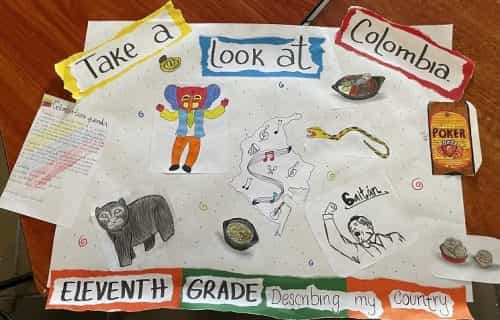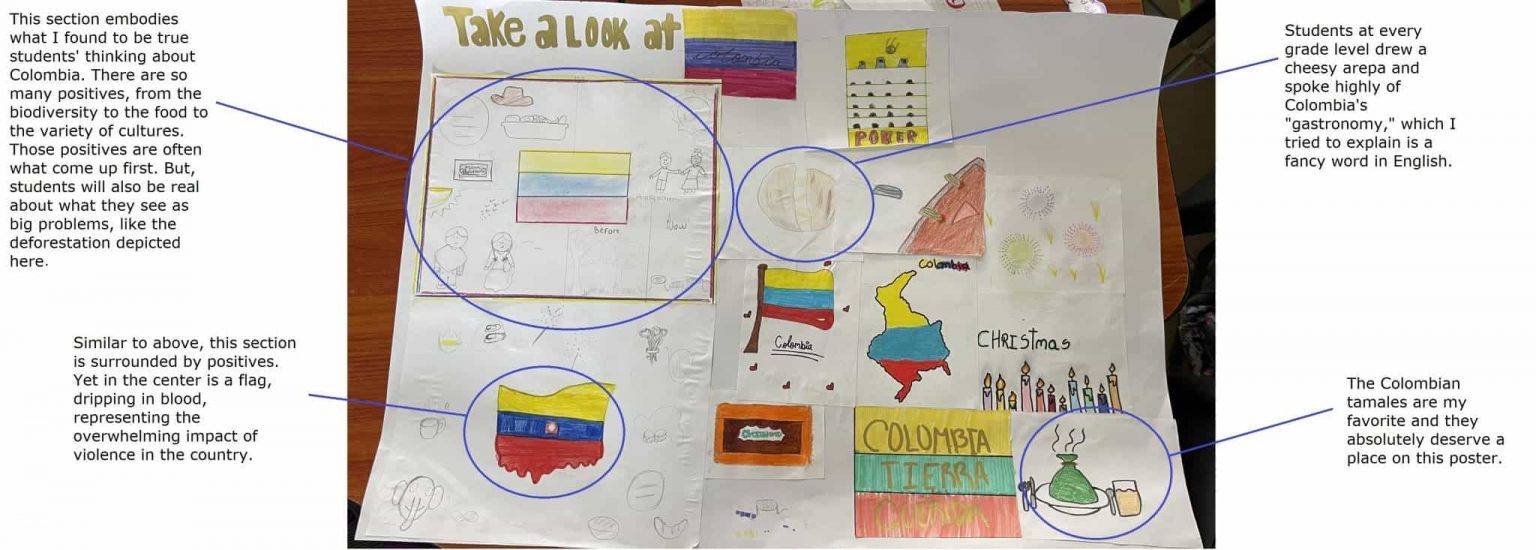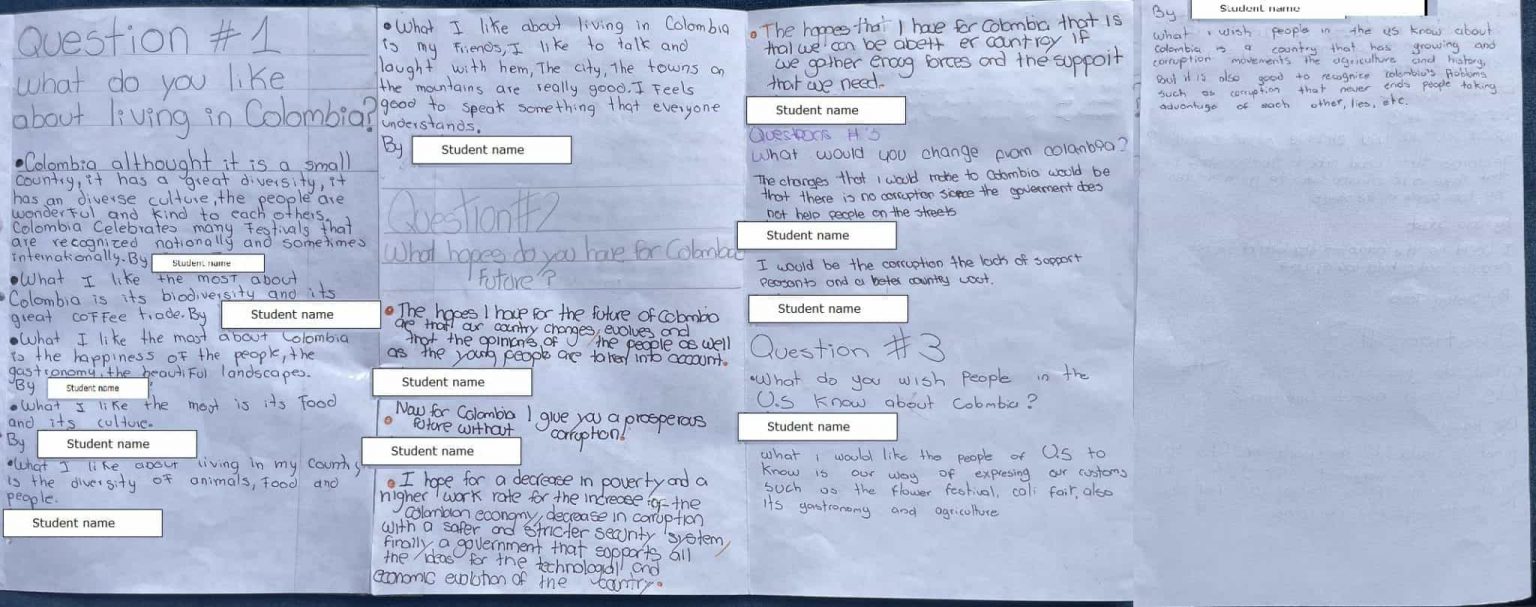I co-taught in Tunja!

Justin Hauver
This is another research update because I spent the last week in Tunja, co-teaching with the English teacher! During my first visit, I noticed right away that “somos un equipo” – we are a team – and that meant that I would not be allowed to simply be an outside observer. Students and teachers alike drew me into conversations and activities in nearly every classroom. Inspired by this ethos, I asked the English teacher if she would be open to collaborating on a project together and she very enthusiastically agreed.
Our weeklong project had a few components:
- Warm-Up: We did a Four Corners activity in Spanish
- Posters: Students then started brainstorming, writing, and drawing things related to either Colombia or their school. This was all put together into a poster-sized collage.
- Questions: Students then got down to answering questions in English.
- Newscast Recording: Finally, each table group of 4-6 students put together a script in English for a “newscast” featuring interviews using the questions from step 3. They practiced their parts and then recorded the newscast.
We did the project with each grade she teaches, 6-11 (Colombian schools go to 11th, then university). With 4-5 hours with each class, most groups we were able to get through all of the activities. Below is a bit more about each piece of the project.
Four Corners
Four Corners is a pretty common activity that can be used in any grade. In the corners of the classroom you place four expressions of agreement:
- I strongly agree
- I sort of agree
- I strongly disagree
- I sort of disagree
Then you hold up a series of opinions, students move to the appropriate corner of the classroom, discuss their reasons with others there, and then a few students share with the whole class. There are also a ton of variations to make it more or less scaffolded for students. For instance, students can be given time to write down their thoughts in a graphic organizer before moving and discussing. The debrief of each opinion can be guided into a fuller discussion. And so on.
After re-introducing myself, explaining my research in general, and outlining how to play Four Corners, we jumped into the activity.
Cats are better than dogs.
This was the first opinion I used in Four Corners. If it’s the first time doing the activity, it’s good to start with something light and maybe a bit silly. Students were pretty split on this, though dogs probably had a slight edge. Common rationales were: dogs are more loyal, man’s best friend, more caring, and more protective. Cats were seen as more independent, easier to care for, and cleaner.
Colegio Tunja is a good school.
To be honest, I expected more dissent with this one but students across the grades overwhelmingly agreed with this. I doubt I’d see such overwhelming positively from my students in the US, even from those that truly enjoyed school and got along with teachers and students. A bit of it might be putting on a show for the foreign visitor or the presence of their actual teacher in the room, but I doubt it. First, the teacher usually earnestly urged students to be honest. Second, students were usually pretty candid with me about their thoughts on Colombia’s issues.
In any case, students had a lot of positive things to say about the school, the teachers, and the community. All of them seem aware that Colegio Tunja uses a different model of education and many can even name Escuela Nueva. For them, the model means they get much more freedom than the normal Colombian school. They are able to work in groups and in general enjoy a more relaxed learning atmosphere where they feel they can ask for help if needed and where everyone is accepted. Most also appreciate their teachers’ efforts to teach in a more dynamic way and they are aware of the closer relationships they are able to build with one another.
I am optimistic about my future.
This one was the first one that had a bit more nuance. The majority were optimistic about their futures, but in every class there were a few students who weren’t so sure. Reasons for being optimistic usually related to having confidence in themselves and feeling prepared by Colegio Tunja for what comes next. Many also positioned themselves in relation to less well-off Colombians. As a private school serving working to middle class families, the students are aware that they enjoy some relative privileges that will help them in the future.
On the other side, students who disagreed usually cited the broader context of Colombia. They were less sure that they alone could overcome what they saw a pretty big challenges, even if they felt they had a lot of skills and some privilege.
I am optimistic about the future of Colombia.
The last one was the only time that a majority, nearly everyone in fact, moved to one of the disagree corners. This was both surprising and not at all surprising to me. It was not surprising because I had heard strong critiques of Colombia’s government from students and teachers on both visits. But I was also taken aback because so many students were so optimistic about their futures. How, I asked them, could you be so positive about your future but so negative about Colombia’s future? A lot of the their responses pointed to the huge societal issues that are simply outside of their immediate circles of control. The corruption, the violence, the lack of opportunities, the unemployment, the fact that so many of Colombia’s brightest minds leave the country. Many actually explained that they intended to leave Colombia as well.
Their responses got me thinking about the limits of “somos un equipo.” How far does that team or community extend? Past the school doors is it back to the individualism that many criticized as fundamental to Colombia’s problems? This is not a criticism of the students or their desires to seek better opportunities elsewhere. In their place, I’d pursue the same. Rather, I’m wondering more systemically about how the school’s model does or doesn’t support civic thinking or empowerment. What might their responses be, for example, if more of their class projects were linked to the broader community? If they worked in classes to research more deeply issues in Tunja or Colombia, designed small scale solutions to, say, reduce environmental pollution or encourage more voter turnout, and them implemented them? Would they have a greater sense of civic efficacy? I don’t know the answers to these question and I don’t even know if such a model is possible, but it’s the kind of idealist education that I’m so interested in figuring out to cultivate.
Posters
After warming up in Spanish with Four Corners, we transitioned to thinking a bit more in English. Students were asked to think of English adjectives and phrases or images that they could draw to represent either Colegio Tunja or Colombia, depending on the theme for that grade. From there I basically jumped from group to group, taking questions, providing help, and chatting as students worked.
As is the case in many classrooms across the US, many of the students struggled with the non-native language and proficiency varied widely across individuals and grades. I’d say the vast majority were around beginner/A1 in terms of language level. That, combined with the custom of the classroom, meant that I spent most of my time speaking in Spanish, trying to draw out students’ English knowledge, providing translation help, explaining different features of English, supporting with pronunciation, and providing transferable rules when possible (things like -dad in Spanish normally becomes -ty in English, as in biodiversidad).
It was a lot of fun to be able to get so much time with so many students. Below are some examples of their posters.


Questions
As students started to finished up their posters, we went around to each group, passing out questions that I had come up with about students’ thoughts on the school and the country. These questions relate to my research interests but were also meant to be a bit more concrete and answerable by students in various grades with various English abilities. Examples include:
- Describe a successful student at Colegio Gimnasio Santander.
- What has been your favorite class at this school and why?
- What do you want to do after graduating from Colegio Gimnasio Santander? Why?
- What do you like about living in Colombia?
- What changes do you think would make Colombia a better country? Why?
Students answered the questions first in Spanish and then in English. As with the poster, I went from group to group to support students and just hang out. Each student had to get my sign off in their notebooks before they could move on recording those answers in “brochures” that I got to take with me. That means I have a bunch of artifacts with students’ opinions about the school and Colombia, giving me additional insight into my research questions.

Newcasts
The last task for students to complete was for them to write and record a newscast using the questions they had been given. To do this table groups divided into different roles. One person took the role of presenter, who welcomed the audience, presented the newscast, and handed it over to the reporter in the field. The reporter was the one asking the questions. The remaining students took on the role of interviewees and responded to the question. First they wrote their script in English, then they practiced it, and finally they went into the hallway to record it.
I had so much fun with students during this part of the project. It took a lot of supporting them and encouraging them to get them to practice their English pronunciation. It was useful to point to my less than perfect Spanish and remind them that the most important thing is to just try. And there were SO MANY BLOOPERS that ended with all of us laughing. In the end, classes did a solid job. Once students finish editing their videos, the English teacher plans to send me the final versions. The videos will also be used to showcase students’ English skills during Cultural Week in October.
Conclusion
In conclusion, I had a ton of fun and learned a bunch from the students. I spent 35 hours working with the English teacher and, because I spent most of the time bouncing from small group to small group, I was able to work pretty closely with 124 different students across six different grades. All of those conversations have enriched my understanding of the school’s educational model and my image of Colombia in general. It was also nice to be back in the classroom with a bunch of quirky adolescents, especially since I had none of the responsibilities of actually being a teacher.
Co-teaching in Spanish was also a new experience that I can check off the bucket list. One time the English teacher even let me know start the class off solo as she spoke with a parent in the office. That was my first time starting a class with a prayer, as is the school’s custom. Actually, I just selected a student to lead the prayer since I don’t know any prayers. The English teacher eventually joined us as we were finishing up Four Corners. I’m proud of how far my Spanish skills have come with only a few summers of studying starting in 2017.
Lastly, I hope that this project was an expression of the reciprocity that I try to keep at the center of my research. The notion of giving something back comes up in Sara Lawrence-Lightfoot’s writings on how to do portraiture. It is important to not simply extract research, but to become a small part of the community through some exchange of time, advice, help, etc. During this project, I certainly felt that exchange while chatting with students, who had many more questions about my life and the US than I had for them. I also hope that I provided something valuable to the English teacher through my co-facilitation and presence as a native speaker. Without a doubt, by Friday I certainly felt like a part of the community, with students fist bumping me on the way to school and teachers casually chatting with me during breaks.
Note: All views expressed are my own, they do not represent the Fulbright or any other organization.